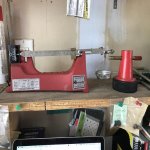I'll second that analysis.
I've only had a few balance beam scales as well as only a few digital scales on my reloading bench over the last 50 years. I have no doubt there's more than a few here who have more hands on experience than I have. And probably a few that have years of working with scales in labs.
However, that said, I think that there are probably very few reloading here where tenth of a grain accuracy actually does affect their rifle's performance at the ranges and for the purposes that they use it for.
I also think that there's more user induced weighing error than scale error for both kinds of scales. By a long shot, for both kinds of scales.
That includes metal and electromagnetic influences around the scale being used, whether or not the scale is actually on a flat surface, is it running on batteries or plugged into house current if it's one of the lower end digital scales, etc. And digital scales can drift (hysterises? Some electrician/instrument basher help me here); my Dillon now drifts like crazy.
Whether powered by batteries or plugged into the electrical recepticle beside your bench, I doubt any of the relatively inexpensive electronic scales have a regulated internal power supply inside them that can deal with changes in voltage, temperature, etc. I tried plugging my Dillon into a computer UPS, thinking it might be a fluctuating power supply problem; no luck.
But on the other hand, balance beam anvils where the beam pivot edges sit get filled with guck, or worse, damaged, and users look at the pointer/line alignment from a slightly different point each time.
With both types of scales, as a general rule, the more you pay for your scale, the better precision and repeatability you get in return. There's the enclosed electronic scales some prominent F-classers show on ScrewTube, while other ScrewTube videos show the work of guys to tune balance beam scales to high degrees of precision who prefer that. Whether the precision outcome in weighing charges actually improves your score, your hunting, etc.... that's up to the guy who paid for the scale to determine.
If there's good news in this for all, it's that many who think they have a problem can probably fix all or nearly all by simply correcting user errors and eliminating conditions that can affect the scale accurately and repeatedly doing it's job. Eliminating potential stray electromagnetic fields/bad ballasts, fluctuating electrical current for electrical scales, temperature changes, not having your eye on the same horizontal plane as the beam indicator and the scale's zero line, sitting on a tilted work surface, accumulated dirt built up in the scale's anvils where the beam's blades sit, etc.
Most (but not all) obsessing over their scale reminds me of my anguished cries the first time I used my brand new borescope to look down my barrels. I didn't realize what junk I was shooting while we were shooting gophers with our varmint rifles down in eastern Montana. Couldn't understand how I could hit anything with a sewer pipe like that screwed on the action. I recovered... with time.
If I was really worried, I'd weigh a light object ten times, a heavy object ten times, and an object about the same weight as my favorite load ten times. Do the results show repeatability of reading throughout the weight range? If you're really obsessed, repeat the test on different days when the house temperature is different.
Is +/- 0.2 gr. a real problem for you? RCBS says my scale is +/-0.1 grain accurate; if it's way out of whack to the point of +/- 0.2 grain, is all lost?
To me, it looks like it gets lost in the other variables on reloading benches: differences in case capacity between the individual cases being loaded, different neck tension when using unannealed brass, a new lot of powder or primers, bullet runout, etc. Maybe the humidity that day in the room where I reload for all that I know.
I did burn up a lot of powder and bullets in a pretty accurate varmint rifle I had, shooting ten shot groups at 300 yards as I varied charges up and down a tenth of a grain, and then groups that were mixed loads that were either plus or minus a tenth of a grain.
No difference between any of them on the targets. But to be fair, that was just one rifle, using just one load that happened to be the most accurate rifle I had at the time. Somebody else's rifle, particularly something like a purpose built benchrest or F-Class rifle, a different powder, perhaps the difference would have been night and day.
And as we're all reloaders used to experimenting... how hard can it be to do repeatability tests on our scales, followed by determining whether .1 or .2 grain differences both ways make a difference?













































































